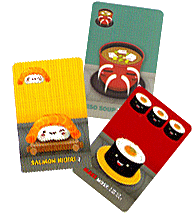
This good fun game can comfortably handle from two up to eight players. Each plays their own hand, and all are seeking to garner most points by selecting from a range of delicious sushi dishes.
These don’t become available at the drop of a hat, however. Furthermore, whilst there’s quite a bit of luck involved, there’s plenty of demand for choosing judiciously.
What to pick, and when ~ deciding whether to piggily pack your own plate, or to nobble someone else’s nosh!
The game’s based on a sizeable pack of nicely designed cards, each of which displays a sushi delight. These delights can contribute to diners’ scores, in an imaginative variety of ways.
Note the use of ‘can’ rather than ‘does’ – some choices lead to sure gains, but not all will do.

For each meal (or game) there’s a menu of eight different, delicious delights available.
The menu shown here is provided by the designers with novice diners in mind.
Of course, there are more challenging ones for those who’ve eaten themselves silly more frequently, and have got better ‘Sushi-sense’. They get more challenging, as different delicacies appear, with differing and more complex demands on diners.
Some delicacies beget scores just from having a single card, whilst others depend on building up combinations or sets of cards.

For example, Nigiri are present on every menu – there are three kinds.
Just on their own, plain ones are worth 1 point whilst salmon gain 2,
and squid bring 3 points.
If they’re placed atop a Wasabi that a diner has already laid down, those scores are trebled !
Miso soup is a bit of a difficult choice. If only one diner chooses it during a turn,
they will gleefully score 3 points.
But if it’s chosen by more than one on that turn, all their Misos are discarded,
along with potential scores. How sad is that !
Misos that were chosen previously will stay put of course – scored at the end of the round.
Maki rolls have small roll-icons at the top of each card – 1, 2, or 3.
At the end of a round, whoever displays most icons gets 6 points, second most gets 4,
and third most gets 2 points.
The meal takes place over three rounds, in each of which everyone has a small supply of cards in hand that they use for each turn. There are eight cards per round – so there are eight turns.
Each turn, diners select just one card from their hand and place it face down, ready flip into open view.
Importantly, everybody reveals at the same time.
Nobody goes first or last … a civilised sushi party, where everybody gets attention at the same time … 😃
So, diners can now see what items were chosen by all and sundry – both this turn and previously. Once everyone’s placed their newly revealed card in their own little space on the table, and have tried to work out what else they might need, so as to generate a score at the end of the round, the next turn starts.
The following turn uses all the cards that diners did not choose. These are passed on to the next-door diner (clockwise) – they get the cards that you just had: less the one you just placed face up.
So everybody gets one less card from which to choose … making for more head scratching.
Several diners may have had to pass cards that they’d much rather have kept for themselves.
Oh well : c’est la vie …. 😢
The meal continues thus until eight card choices have been made and placed in each of three rounds. At the end of each round, players will have taken their scores – though desserts aren’t scored until the end of the meal.
How could it be otherwise?
You can never be sure who’s going to get there and be super-sushi. At times diners might go for a quick-score choice, and then start to gather up delicacies where they’ll have to be two or three to make it worthwhile.
What are they up to?

This single sheet isn’t so much rules, but a guide to all the items that are on the menu the publisher has recommended as a good starter. It helps new players to get used to the way that different cards can be used to score.
- it’s not designed in, but it can turn into a bit of a party
- not a great deal to learn
- but learning what to do and when – that’s a different story!
- every card carries a mini-guide to how it scores
- the second game flows much easier
- very little time to set up
- luck is involved, in the way that delicacies appear
- choices matter ~ immensely

► Want to eat well … why not buy at a games shop?
